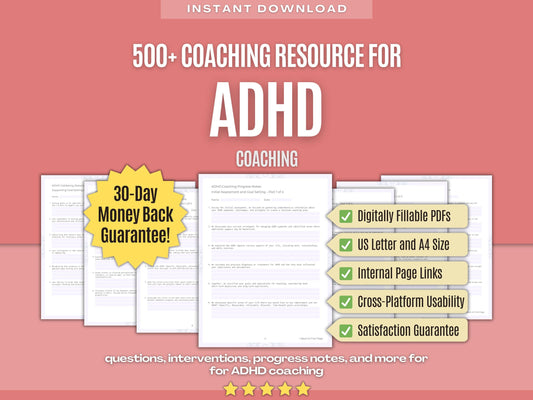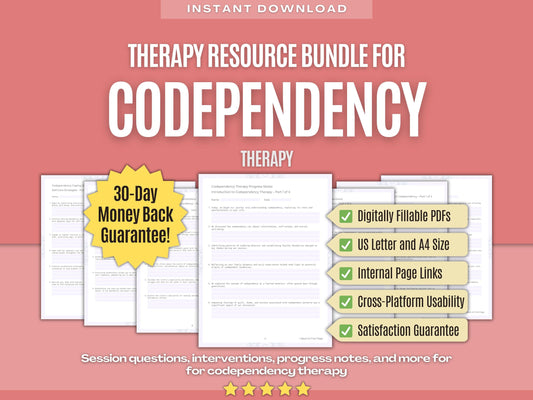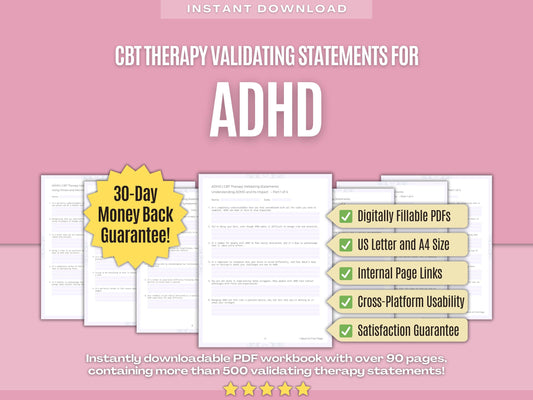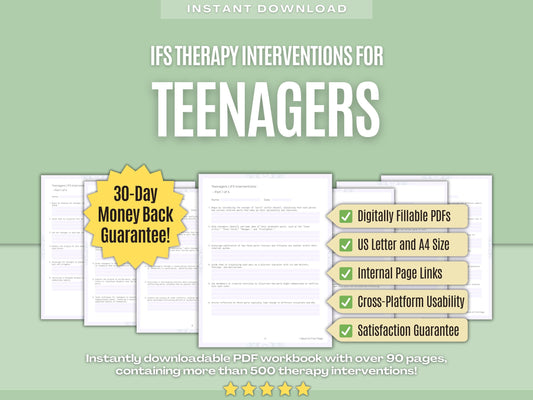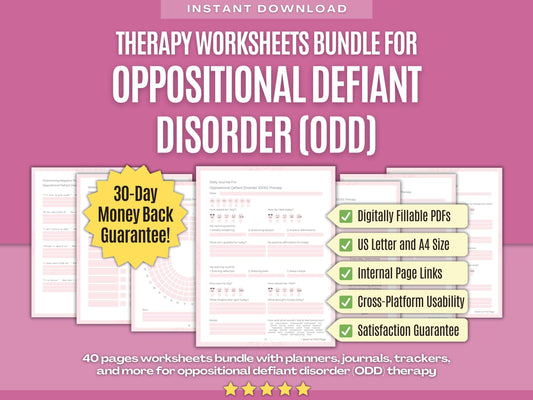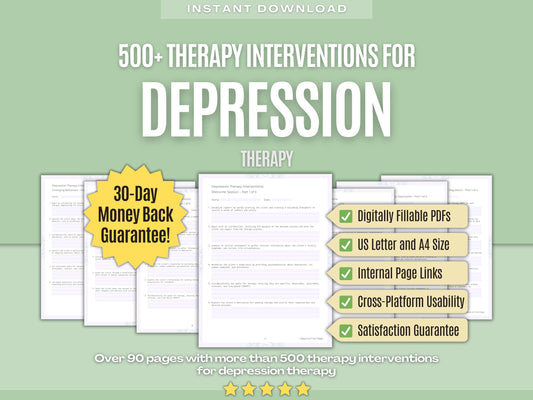Elevate Your Therapy and Guide Your Clients to Inner Healing with Our Grief and Loss Coping Skills! ✨
1. Acknowledging Your Grief
- Begin by acknowledging the reality of your loss, recognizing that denial or avoidance can prolong the grieving process and impede healing.
- Express your feelings through creative outlets such as art, writing, music, or dance, as these mediums can provide a safe and constructive way to process emotions.
- Seek support from trusted friends, family members, or a therapist who can provide a listening ear, empathy, and validation for your feelings.
- Take care of your physical health by prioritizing sleep, nutrition, exercise, and relaxation, recognizing that self-care plays a crucial role in coping with grief.
- Join a grief support group where you can connect with others who have experienced similar losses, share your story, and learn coping strategies from one another.
- Create a grief journal to document your thoughts, feelings, and experiences throughout the grieving process, providing a therapeutic outlet for self-reflection and expression.
- Practice gratitude by focusing on moments of joy, connection, and meaning in your life, even amidst the pain of loss.
- Allow yourself to seek moments of laughter, pleasure, and relaxation, recognizing that it's okay to experience moments of happiness amidst your grief.
- Practice forgiveness towards yourself and others, releasing feelings of guilt, resentment, or anger that may be hindering your healing process.
- Set boundaries with others to protect your emotional well-being, communicating your needs and limitations as you navigate your grief journey.
- Engage in volunteer work or acts of kindness in honor of your loved one, finding meaning and purpose in giving back to others.
Need more? Find all 500+ Coping Skills for Grief and Loss Therapy in our Digital Workbook!
2. Expressing Your Feelings
- Start by verbally expressing your emotions to a trusted friend, family member, or therapist, articulating your feelings in a safe and supportive environment.
- Write a letter to your loved one, expressing your thoughts, feelings, and memories, even if you don't intend to send it, as a way to process your emotions and communicate with them.
- Use music as a means of emotional expression, listening to songs that resonate with your feelings or creating playlists that reflect your mood and experiences.
- Practice mindfulness meditation to observe and acknowledge your emotions without judgment, allowing them to arise and pass naturally without becoming overwhelmed by them.
- Express your emotions through poetry or creative writing, using language to capture the depth and complexity of your feelings in a tangible form.
- Engage in therapeutic activities such as role-playing, storytelling, or guided imagery to explore and express your feelings in a structured and supportive context.
- Seek out opportunities for catharsis, such as attending a grief retreat, participating in a ritual or ceremony, or engaging in a symbolic act of release.
- Practice assertive communication by expressing your needs, boundaries, and feelings to others in a clear and respectful manner, advocating for yourself during this challenging time.
- Use humor as a coping mechanism to find moments of levity and lightness amidst the heaviness of grief, allowing laughter to provide temporary relief from sadness.
- Practice self-compassion by offering yourself kindness, acceptance, and understanding as you navigate the ups and downs of grief, recognizing that it's okay to feel what you feel.
- Use technology to connect with others and share your feelings, whether it's through video calls, online forums, or social media platforms where you can find support and validation.
Need more? Find all 500+ Coping Skills for Grief and Loss Therapy in our Digital Workbook!
3. Coping with the Physical Effects of Grief
- Prioritize regular exercise as a coping mechanism to alleviate physical tension, reduce stress, and boost mood through activities such as walking, swimming, or yoga.
- Establish a consistent sleep routine by practicing good sleep hygiene habits, such as setting a regular bedtime, creating a relaxing bedtime routine, and avoiding stimulating activities before bed.
- Take breaks throughout the day to engage in brief periods of rest and relaxation, allowing your body and mind to recharge and recover from the physical toll of grief.
- Stay hydrated by drinking plenty of water throughout the day, as dehydration can worsen physical symptoms such as headaches, fatigue, and muscle tension.
- Practice good posture and body mechanics to prevent physical discomfort and strain, especially during periods of heightened stress and tension.
- Use heat or cold therapy to alleviate physical symptoms such as muscle tension, inflammation, or headaches, by applying heating pads, ice packs, or hot/cold compresses as needed.
- Engage in activities that promote relaxation and stress reduction, such as spending time in nature, listening to calming music, or practicing mindfulness meditation.
- Use pain management techniques such as over-the-counter pain relievers, topical creams, or therapeutic massage to address physical discomfort associated with grief-related symptoms.
- Create a comfortable and supportive sleep environment by investing in a quality mattress, pillows, and bedding, and minimizing noise and light disturbances that may disrupt sleep.
- Engage in activities that promote physical connection and intimacy, such as hugging, cuddling, or holding hands with loved ones, to foster feelings of comfort and support.
- Seek out professional support from a physical therapist, occupational therapist, or other healthcare provider who can offer personalized guidance and treatment for managing physical symptoms of grief.
Need more? Find all 500+ Coping Skills for Grief and Loss Therapy in our Digital Workbook!
4. Creating Rituals of Remembrance
- Establish a regular time and space for engaging in rituals of remembrance, whether it's a weekly candle-lighting ceremony or a daily moment of reflection at a designated altar.
- Invite loved ones to participate in rituals of remembrance, whether it's family members, friends, or support group members, fostering a sense of connection and community in honoring your shared loss.
- Create a ritual calendar to mark significant dates and anniversaries, such as birthdays, holidays, or the anniversary of your loved one's passing, planning special rituals to honor and remember them on these occasions.
- Write and recite poetry, prayers, or affirmations during rituals of remembrance, expressing your thoughts, feelings, and memories in a heartfelt and meaningful way.
- Use rituals of remembrance to express gratitude for the time you shared with your loved one, acknowledging the gifts they brought into your life and the memories you continue to cherish.
- Create a memory box or altar where you can display photos, letters, and keepsakes that remind you of your loved one, adding to it over time and revisiting it regularly as a source of comfort and inspiration.
- Incorporate rituals of remembrance into your daily routine, whether it's starting each day with a moment of silence or ending each evening with a prayer or reflection, to provide structure and solace in the midst of grief.
- Create rituals of remembrance that involve movement and physical expression, such as lighting candles, releasing balloons, or planting flowers, as a way to channel emotions and facilitate healing.
- Explore the use of ritual objects and tools, such as crystals, incense, or sacred symbols, to enhance the atmosphere and energy of your rituals and create a sense of reverence and sanctity.
- Create rituals of remembrance that incorporate elements of nature, such as planting trees, scattering ashes, or holding ceremonies outdoors, to connect with the cycles of life and find solace in the beauty of the natural world.
- Incorporate elements of mindfulness and meditation into rituals of remembrance, using guided imagery, deep breathing, or visualization techniques to cultivate presence, awareness, and peace.
Need more? Find all 500+ Coping Skills for Grief and Loss Therapy in our Digital Workbook!
5. Exploring Spiritual and Cultural Beliefs
- Reflect on your personal spiritual and cultural beliefs surrounding death, loss, and the afterlife, recognizing that these beliefs can offer comfort, guidance, and meaning during times of grief.
- Seek guidance from spiritual leaders, clergy members, or elders within your faith community, who can offer wisdom, perspective, and spiritual guidance as you navigate the challenges of grief and loss.
- Participate in religious or cultural rituals and ceremonies that honor and commemorate the dead, whether it's attending memorial services, performing funeral rites, or observing cultural traditions for mourning and remembrance.
- Seek out literature, poetry, or music that resonates with your spiritual or cultural beliefs about death, loss, and the journey of the soul, finding inspiration, comfort, and solace in artistic expressions of grief and healing.
- Explore alternative spiritual or cultural practices that resonate with your beliefs and values, such as mindfulness meditation, energy healing, or shamanic journeying, as additional tools for coping with grief and finding inner peace.
- Seek out spiritual or cultural teachings that offer insights into the nature of suffering, impermanence, and the cycle of life and death, finding wisdom and guidance for navigating the challenges of grief and finding acceptance and peace.
- Practice gratitude and appreciation for the blessings and gifts in your life, recognizing the interconnectedness of all beings and the preciousness of each moment, even amidst the pain of loss.
- Seek out opportunities for spiritual growth and transformation through practices such as forgiveness, compassion, and self-reflection, recognizing that grief can be a catalyst for profound healing and awakening.
- Engage in rituals or ceremonies that honor your ancestors and lineage, recognizing the wisdom, strength, and resilience that have been passed down through generations and drawing on their support and guidance in times of need.
- Seek out spiritual or cultural practices that promote inner peace, balance, and harmony, such as yoga, tai chi, or qigong, finding grounding and centering in the midst of life's challenges and transitions.
- Create rituals or ceremonies that honor and celebrate the life of your loved one, incorporating elements of your spiritual or cultural beliefs to create meaningful and personalized tributes.
Need more? Find all 500+ Coping Skills for Grief and Loss Therapy in our Digital Workbook!
6. Rebuilding Your Identity
- Take time to explore and rediscover your interests, passions, and values, recognizing that your identity may evolve and change as you navigate the process of grief and loss.
- Connect with others who share your interests and values, whether it's joining clubs, groups, or communities that align with your passions, or seeking out like-minded individuals who can offer support and companionship.
- Seek out professional support from a therapist or counselor who can provide guidance, validation, and coping strategies for rebuilding your identity after loss, tailoring their approach to your individual needs and circumstances.
- Take steps to nurture your physical, emotional, and spiritual well-being, whether it's through exercise, nutrition, relaxation techniques, or spiritual practices that promote balance and harmony in your life.
- Seek out opportunities for growth and learning as you rebuild your identity after loss, whether it's through education, training, or personal development initiatives that empower you to pursue new interests and challenges.
- Practice resilience and adaptability as you navigate the challenges and transitions of rebuilding your identity after loss, recognizing your own strength, courage, and capacity for growth and transformation.
- Seek out opportunities for self-expression and creativity as you explore and express your identity after loss, whether it's through writing, art, music, or other forms of creative expression that allow you to share your thoughts, feelings, and experiences with others.
- Seek out supportive relationships and social connections that nurture and affirm your sense of self and identity, whether it's through friendships, family bonds, or romantic partnerships that offer love, acceptance, and understanding.
- Be patient and kind with yourself as you navigate the process of rebuilding your identity after loss, recognizing that healing is a journey that unfolds over time, and that each step forward is a testament to your strength, resilience, and capacity for growth.
- Seek out opportunities for connection, community, and social support as you rebuild your identity after loss, whether it's through support groups, therapy, or other resources that offer validation, understanding, and encouragement.
- Explore your roles and responsibilities in your various relationships and contexts, recognizing that your identity may be shaped by your roles as a parent, partner, friend, colleague, or community member.
Need more? Find all 500+ Coping Skills for Grief and Loss Therapy in our Digital Workbook!
7. Engaging in Self-Care Practices
- Prioritize adequate sleep by establishing a consistent sleep schedule and creating a relaxing bedtime routine that promotes restful sleep.
- Practice mindful eating by paying attention to your body's hunger and fullness cues, and choosing nutritious foods that nourish your body and mind.
- Take breaks throughout the day to rest and recharge, whether it's through short meditation sessions, deep breathing exercises, or simply taking a few moments to relax and unwind.
- Practice relaxation techniques such as deep breathing, progressive muscle relaxation, or guided imagery to reduce stress and promote feelings of calm and tranquility.
- Set boundaries to protect your time, energy, and emotional well-being, recognizing that it's okay to say no to things that feel overwhelming or draining.
- Practice self-compassion and kindness towards yourself, recognizing that grief is a natural and normal response to loss, and that it's okay to seek support and assistance when needed.
- Take time to reflect on your feelings and experiences, whether it's through journaling, meditation, or talking with a trusted friend or therapist.
- Practice gratitude and appreciation for the blessings and gifts in your life, recognizing the moments of love, connection, and beauty that still exist amidst the pain of loss.
- Connect with your spiritual beliefs and practices, whether it's through prayer, meditation, or participating in religious or cultural rituals that bring you comfort and solace.
- Engage in acts of kindness and compassion towards others, finding fulfillment and purpose in giving back to your community and making a positive difference in the lives of others.
- Create a nurturing and supportive environment in your home, whether it's through decluttering and organizing your space, surrounding yourself with comforting items, or creating a peaceful sanctuary for relaxation and reflection.
Need more? Find all 500+ Coping Skills for Grief and Loss Therapy in our Digital Workbook!
8. Helping Others Grieve
- Listen actively and empathetically to the person who is grieving, providing a safe and supportive space for them to express their thoughts, feelings, and experiences without judgment or interruption.
- Validate the person's feelings and experiences, recognizing that grief is a complex and individual process that may manifest differently for each person.
- Offer to accompany the person to appointments, meetings, or social gatherings if they feel overwhelmed or anxious about attending alone, providing companionship and support as needed.
- Provide reassurance and encouragement to the person, reminding them that it's okay to take things one day at a time and that healing takes time, patience, and self-compassion.
- Encourage the person to engage in self-care activities that promote their physical, emotional, and mental well-being, such as exercise, relaxation techniques, or creative outlets that offer comfort and solace.
- Offer to listen and provide emotional support whenever the person feels overwhelmed or distressed, allowing them to express their feelings and emotions in a safe and nonjudgmental environment.
- Encourage the person to honor their loved one's memory in ways that feel meaningful and comforting to them, whether it's through rituals, ceremonies, or creative expressions of remembrance.
- Validate the person's experiences of grief and loss, recognizing that their feelings of sadness, anger, guilt, or confusion are all normal and natural reactions to the loss of a loved one.
- Offer to accompany the person on outings or activities that they enjoy, providing companionship and support as they navigate the ups and downs of their grief journey.
- Encourage the person to seek out social support from friends, family members, or support groups who can offer understanding, empathy, and companionship during their time of grief.
- Offer to help the person create a support network of friends, family members, and professionals who can offer guidance, validation, and practical assistance as they navigate their grief journey.
Need more? Find all 500+ Coping Skills for Grief and Loss Therapy in our Digital Workbook!
9. Setting Healthy Boundaries
- Identify your personal values, needs, and limits to gain clarity on what boundaries are important for you to establish in your relationships and interactions.
- Practice self-awareness and mindfulness to recognize when your boundaries are being crossed or violated, allowing yourself to tune into your emotions and physical sensations as signals that your boundaries are being challenged.
- Set boundaries around your time and energy by prioritizing self-care activities and commitments that align with your needs and values, and respectfully declining or renegotiating obligations that feel overwhelming or draining.
- Recognize that setting boundaries is an ongoing process that requires practice, patience, and self-reflection, and be open to adjusting your boundaries as needed based on changing circumstances and feedback from others.
- Set boundaries around physical space and personal belongings to protect your privacy and autonomy, and communicate your expectations clearly to others to ensure mutual respect and understanding.
- Practice self-compassion and kindness towards yourself as you navigate the process of setting boundaries, recognizing that it's normal to feel uncomfortable or conflicted at times, and that growth and change take time.
- Establish boundaries around your physical and emotional space by being selective about who you allow into your inner circle and setting limits on how much time and energy you invest in relationships that feel draining or toxic.
- Practice self-care activities such as meditation, exercise, or creative expression to strengthen your sense of self-worth and resilience, and to replenish your energy and motivation for setting and maintaining boundaries.
- Be consistent in enforcing your boundaries across different areas of your life, and recognize that setting boundaries is an ongoing practice that requires commitment and perseverance.
- Practice active listening and empathy in your relationships, and respect others' boundaries and limits as you would expect them to respect yours, fostering mutual understanding and trust.
- Set boundaries around your finances and material possessions to protect your financial security and independence, and be assertive in communicating your expectations and boundaries with others when it comes to money and material resources.
Need more? Find all 500+ Coping Skills for Grief and Loss Therapy in our Digital Workbook!
10. Celebrating Progress and Healing
- Reflect on the progress you've made in your healing journey, acknowledging the challenges you've overcome and the growth you've experienced since the beginning of your grief.
- Practice self-compassion and kindness towards yourself, recognizing that healing from grief is a gradual process and that it's okay to be gentle with yourself along the way.
- Create rituals or ceremonies to mark significant moments in your healing journey, such as anniversaries of your loved one's passing or milestones in your own personal growth and healing.
- Engage in activities that bring you joy and fulfillment, whether it's pursuing hobbies and interests, spending time with loved ones, or participating in activities that bring you a sense of purpose and meaning.
- Set aside time for reflection and introspection to check in with yourself and assess how you're feeling physically, emotionally, and mentally as you continue on your healing journey.
- Use creative expression as a way to celebrate your progress and express your feelings, whether it's through art, music, writing, or other forms of creative expression.
- Practice mindfulness and presence in your daily life, allowing yourself to fully engage and immerse yourself in each moment with openness, awareness, and acceptance.
- Celebrate your resilience and strength in the face of adversity, recognizing the courage and determination it takes to continue on your healing journey.
- Engage in acts of kindness and compassion towards yourself and others, finding fulfillment and purpose in giving back to your community and making a positive difference in the lives of others.
- Cultivate a sense of hope and optimism for the future, recognizing that healing is possible and that each step forward brings you closer to a place of peace and acceptance.
- Practice forgiveness and acceptance towards yourself and others, recognizing that healing involves letting go of blame, resentment, and judgment.
We hope that our coping skills for Grief and Loss therapy will help you to elevate your therapy practice and guide your clients to inner healing! Do you need more coping skills for Grief and Loss therapy? Find them all in our Digital Workbook! Or do you have any questions or suggestions for us? Please feel free to contact us at any time!


